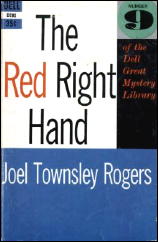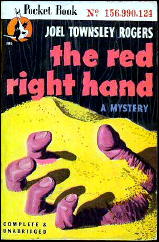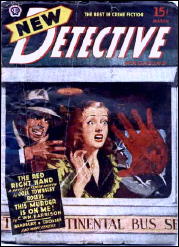Sun 13 Sep 2009
A 1001 MIDNIGHTS review: JOEL TOWNSLEY ROGERS – The Red Right Hand.
Posted by Steve under 1001 Midnights , Pulp Fiction , Reviews1 Comment
by Marcia Muller:
JOEL TOWNSLEY ROGERS – The Red Right Hand. First published in New Detective Magazine, March 1945. Reprinted many times, in both hardcover and soft. Shown: Pocket 385, pb, 1946; Dell D203, pb, Great Mystery Library #9, 1957.

This classic suspense novel has the quality of a hallucination. From the opening paragraph, we are drawn into a strange world where eerie and seemingly impossible events are happening; and as we view them through the eyes of the narrator, Dr. Harry Riddle, we begin, as he does, to believe in their reality and to search desperately for some rational explanation for them.
The story begins after most of the events have taken place, with Riddle trying desperately to puzzle them out as he sits in the study of Adam MacComereau, a professor emeritus of psychiatry at Harvard.
The late Adam MacComereau, we learn. Murder has been done more than once. Various shadowy and frightening events are described, without their chronology or connections being given. There is a woman asleep on a nearby sofa toward whom Riddle feels protective, while also holding back fear of his own insanity. And as he sits there, thinking about the events that have passed, he begins to reconstruct what they really signify.

While driving from Vermont to New York City, Riddle had car trouble on a back road; when he finally got under way, he encountered the woman, Elinor Darrie, lost and fleeing through the underbrush. As Riddle tells us, “It was a simple enough incident.”
Elinor and her fiance, Inis St. Erme, were driving to Vermont to be married. On the road they picked up a tramp-a little, twisted man whom Riddle comes to think of as Corkscrew — and when they stopped for a picnic, there was a fight between the tramp and St. Erme. Elinor heard a terrifying scream and fled. Riddle and Elinor investigated the spot and found a quantity of blood, but nothing else.
As Riddle says, “It was such a damned ordinary and commonplace crime, on the face of it.” But other aspects surface — such as St. Erme’ s missing right hand; a mutilated blue hat that Riddle found on the road before he met with Elinor; the noise “like a great frog croaking in the weedy ditch” near where Riddle’s car broke down; and the ugly little man, Corkscrew — who is he and how has he gotten away after apparently doing murder?

This is a dizzying and confusing novel, but pleasurably so. And when the action has been unraveled, its apparent solution explained, confusion is initiated again, and more action occurs. And when that has been unraveled, its solution stands alone, and the result is stunning indeed.
In thinking over the wonderful experience of reading The Red Right Hand, the reader can only marvel at how the author constructed such a baffling and complex plot without leaving a thread untied. And — corollary to that — how he did so without driving himself as mad as his narrator fears he is becoming.
Rogers, however, did remain sane and capable of writing other memorable novels: Lady with the Dice (1946) and The Stopped Clock (1958). In addition, he wrote reams of fiction for both the pulp and slick magazines, and a first (but less memorable) novel, Once in a Red Moon (1923).
———
Reprinted with permission from 1001 Midnights, edited by Bill Pronzini & Marcia Muller and published by The Battered Silicon Dispatch Box, 2007. Copyright © 1986, 2007 by the Pronzini-Muller Family Trust.
Editorial Comment. As you might recall, I’d intended to post the three Ruth Rendell reviews from 1001M this weekend, but as usual, the real world interfered. I’ll get those uploaded in the next couple of days, I hope, but in the meantime, I thought this alternative choice might be appropriate.
Geoff Bradley’s review of this book, which you can find here, has generated more comments than usual — including my own admission that I’ve yet to read it. Perhaps the book falls into a category that might called Classic Novels That Everyone’s Heard About But Relatively Few Have Read.
If the combination of Geoff’s and Marcia Muller’s reviews don’t tempt you into reading it, if you haven’t already — and I doubt that anyone could say more about the story than Marcia without revealing everything — than nothing will!
As for me, I know when I’ve run out of excuses. I also know where my copy of the Pocket paperback is, and I’ll start reading it this week. You can take that statement to the bank and cash it. It’s as good as gold.
September 14th, 2009 at 2:56 pm
The prose doesn’t exactly sparkle, and the plot spins its wheels at times when it really should be moving, BUT somehow I found it compellingly readable, probably because I thought I was a step ahead of Rogers till the end, when I found he’d been… well, wait till you read it.